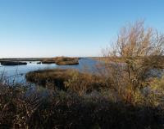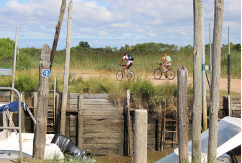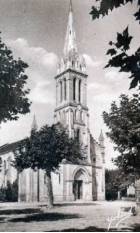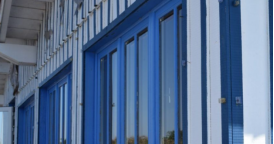Audenge, Gironde, Nouvelle-Aquitaine 作者: 来源: 发布时间:2021-01-11
I. Population and Area
Total Area: 82, 09 km2 (31.69 sq mi)
Population in 2017: 7 993
Population Density: 97 /km2 (252 /sq mi)
II. Natural Geography (environment and resources)

Audenge is located on the Arcachon basin, between Biganos and Lanton. It is part of the Pays de Buch and the communes of the Landes de Gascogne regional natural park.
The neighboring municipalities are Saint-Jean-d'Illac in the north-northeast, Cestas in the far northeast, in quadripoint (point on the surface of the Earth that touches four distinct regions), Marcheprime in the east, Biganos to the south and Lanton to the northwest. The Arcachon basin is located at the southwestern limit of the municipal territory.
III. Economy
Employment income (%): 76.4 (2016)
Poverty rate by age group of the tax advisor(%): 9 (2017)
Average employment income (€): 2 342 net per month (28 104 net per year)(2014)
IV. Industrial Characterisitics
MONSIEUR ANTONY RAFFIN, an individual entrepreneur, has been in business for 12 years. Based in AUDENGE (33980), it specializes in the business of breeding other cattle and buffaloes. Societe.com lists 2 establishments and no events.
Leech farming has existed in Audenge since the 19th century. A single breeder exports throughout France. These annelids are used for therapeutic purposes thanks to their anticoagulant properties. Today, the company is the only French breeding of medicinal leeches and is owned by a company which operates the Audenge basins and exports all over the world.
V. Attractions
Le domaine de Certes-Graveyron (The domain of Certes-Graveyron)

Placed in the Natura 2000 area of the basin, the area is protected by its classification in ZICO (Important Zone for Bird Conservation) and in ZPS (Special Protection Zone according to European law).
History: The Marquis of Civrac, Lord of Lamothe, was the initiator of the development of the salt marshes in the 18th century by building many locks which allow to maintain a constant water level. Ernest Valeton de Boissière, heir to the estate in 1843, transformed the estate into a fish farm.
Text extracted from a trail sign:
Certes trail sign Some pools are dry, others closer to the entrance to the area are covered with nets. Fish raised in Certes naturally penetrate with the tides of the Arcachon basin. The main species are the muge, the sea bass and the eel. These fish tolerate large variations in salinity and temperature in the waters of the basin.
In shallow dishes, the water is relatively warm and well lit, which allows the development of many living organisms, the basis of fish food. In turn the fish are the prey of the heron, the egret and the cormorant. Protecting fish is the reason why nets are installed in certain tanks.
The aquatic plants of the "dishes", abundant food of the herbivores should not however proliferate because they "asphyxiate" the aquatic environment. The dishes are therefore regularly dried to eliminate the particularly invasive green algae.
The Certes fish farms work naturally because fish and their food are not introduced by humans. The main intervention of this consists in maintaining the environment to prevent invasion by vegetation and filling with mud and then, of course, harvesting.
2. le Coeur du Bassin d'Arcachon

Culture is omnipresent in the Heart of the Basin which counts: two performance halls, a cinema, three media libraries, two libraries and an artists' hut on the port of Audenge where many works of painters, sculptors and craftsmen are exposed. Associations also contribute to the development of culture and the safeguarding of our heritage. This is the case of Gardarem, guardian of memory in the Old Port of Taussat, who preserves old tools used by gemmers and oyster farmers of the past. All these places allow you to
read, learn in a fun way and contemplate objects loaded with history and know-how.
With family or friends, climb, jump, slide, paddle, sail, gallop, aim, drive ... and above all have fun! There are many activities at the Coeur du Bassin, there is something for everyone: horse riding, golf, discovery of gardens, games and theme parks, karting, skate park and city stadium, paintball, fishing, tennis lessons and squash, canoeing, sailing, paddle and Cap 33 sports activities allow you to keep fit while having a fun time.
3. L’ancienne église Saint Paul (The old Saint Paul church)

The old Saint Paul church was built in 1878 by Bordeaux architect M. Mondet. You can see a statue of Saint Yves, patron saint of fishermen, whose feast on May 19 is celebrated around an annual event in Audenge.
It is in the middle of the current cemetery that the old Audenge church stood. At XIXth century, Audenge grew and the church became too small while its condition was deteriorating rapidly as well as that of the presbytery, yet still standing days near the Croix du Vieux-Bourg. In 1817 it was the bell that broke (which suggests that the other had already disappeared) but was replaced on instances of Mayor Pierre POMADE. Finally, in 1829, the repair work on the church and the bell tower are started. Difficulties constantly arose, and even, one day, Mayor and Curé came to blows but everything being good that ends well, the works were finished in July 1830 by sieur LABUCHETTE, entrepreneur from Castelnau en Médoc. In 1841 with Numa BEZIAN as Mayor, there is again a question of repairing the bell tower.
From there the "affair" of the church and its bell tower deeply divided the commune of Audenge which divided into two camps: that of the advocates of simple repairs and that of the reconstruction of a new church, larger, more beautiful and better located in the center of the village, in the new district of Places, midway between the two extreme districts of Vieux-Bourg and Certes. In its session of February 18, 1872 the Municipal Council by 7 votes to 3 decides that a new church will be built in Places. To cover the expense, we will sell or grant communal moors. The same year, the architect Jean Jules MONDET officially appointed, notes in his expert report that the state of the church is very bad. This report states that the main nave appears to date back to the 11th Century. Jean Jules MONDET concludes that the church cannot be repaired and that it is necessary to build one new; he will be in charge of the work. At the same time, he also affirms that it is necessary to rebuild the new presbytery. But many inhabitants of Audenge hold on to their old church and in 1872 a petition addressed to Prefect and bearing a large number of signatures, true and false it seems, insists that one does not don't change the church. However in 1873 a letter from Mayor DUVIGNEAU addressed to the Prefect asked him that the church be rebuilt to new quickly because the sessions of the municipal council become stormy and some residents threaten not to be buried in the cemetery if the church is moved, in Bas-Vallon one of them actually carried out his threat.
4. La cabane bleue aux artistes (The artists' blue hut)

An exhibition place from February to November where painters, sculptors, ceramists, writers follow one another. A meeting place imbued with the authenticity of the port and its ancestral activity.
Located at the end of the port of Audenge, in a very busy place in the city, the Cabane Bleue is a place full of authenticity, appreciated by the artists who exhibit their creations there throughout the year.
It is this possibility of exchange with the creators as well as the diversity of exhibitions that visitors to the cabin appreciate.
The artists' blue hut is known in the artistic milieu of the Arcachon Basin and there are more and more visitors.
VI. History
In 1500, the "Captalate of Certes" was born from the split of the Captalate of Buch. Two villages coexist: Certes and "Vieux-Bourg" (Audenge).
In 1620, Jean Castaing said the "Broy" (the "Joli"), merchant of La Teste, bought the barony of Audenge.
The Civrac house replaced, around 1766, the castle of the old feudal motte; then it was demolished in its turn around 1866 to be replaced by the castle of Certes, by Ernest Valeton de Boissière.
In the 18th century, the captalate of Certes became Audenge.
His patron saint is Saint Yves, patron saint of fishermen.
For more information on the situation of the town in the 18th century, see the work of Jacques Baurein.
During the Revolution, the parish of Saint-Paul d'Audenge formed the commune of Audenge.
1800: birth of the canton of Audenge (Biganos, Mios, Lanton, Andernos and Lège).
1836: Jean Frix Numa Bezian mayor of Audenge (1800-1879, first cousin by marriage of Pierre elder son of Jean Duvigneau, dit Caudéran, grandfather of Jacques Duvigneau) unifies Certes and Audenge.
The Duvigneau brothers, Jacques dit "Chéri" and his brother Armand, undertook successively from 1870 and until 1922, the development of Audenge. They urbanize the center, creating paths lined with plane trees. They built the town hall, the schools, the church, the port, the station and the public garden which would later be named after their patronym.
Audenge's arms are emblazoned as follows:
Azure to the pinnace surrounded by silver sailing on a sea of the same, surmounted by a golden sun moving with the stroke of the chief, the chief gone to the first sewn of sand loaded with a golden parasol pine and to second sewn Gules loaded with a goat head surrounded by gold.
A history dating back to the Neolithic:
Evidence of activities and organized life dates from the Neolithic. Archaeological excavations carried out on the Maignan site have revealed:
1. ax points
2. kitchen utensils and
3. remains of pitch ovens
Surveys carried out in April 2008 on the Audenge site revealed a singular structure formed by two pits built with tiles and fragments of pitch jars built with raw clay. This little-known system could belong to one of the refining phases of tarry products.
The Domain of Certes:
The Marquis de Civrac inherited the lordship of Certes in 1757, which included 100,000 ha of moorland between Audenge and Saint-Jean-d'Illac.
The estate was developed during the second half of the 18th century for the production of salt with a vast network of seawater basins connected by sluice gates which maintained a constant and renewed water level. First of all exempt from taxes, saliculture was an economic success, and nearly 1000 tonnes of salt were thus extracted from the marshes each year. But the taxes were reinstated under pressure from the Charente salt producers. The Marquis de Civrac died ruined in 1768.
Ernest Valeton de Boissière, benefactor:
A personality is particularly linked to Audenge, Ernest Valeton de Boissière (1811-1894), processor of the Domaine de Certes in fish farming and benefactor of public education.
He inherited the estate in 1843 and, with his innovative ideas, really revived the Domaine de Certes by replacing saliculture with fish farming.
Utopian, follower of Fourier and Saint-Simon, he says he works only for social progress. He plants pines, raises fish and multiplies philanthropic works.
Protestant anticlerical, it creates mixed schools (the college of Audenge is undoubtedly the first mixed college of France).
He regularly invites all the villagers to the "holy sausage" celebrations. He left for the United States in 1852 and settled in Kansas in 1869 to create an ideal Fourier community there called Silkville.
He definitively returned to Certes in 1892 to die there on January 12, 1894. He was buried on his estate. When he died, he wanted the estate to be sold and the balance to be placed, inter alia, for the benefit of Audenge for public education.
VII. Other information
FOREST: At the heart of the Landes de Gascogne Regional Natural Park, the Audenge municipal forest totals 1,846 hectares, including 1,696 hectares of forest or associated area (moors, lakes, lagoons, etc.).
The communal forest:
It represents 1846 Hectares in its entirety, distinguishing:
1. 1556 Ha of productive forest area
2. 140 Ha of environments associated with the forest (moors, lakes, lagoons, soils ...)
3. 150 ha of agricultural and various uses.
This 1556 Ha forest area is therefore devoted to the production of maritime pine treated in regular forest, to produce quality timber.
Maritime pine is a conifer of the pinaceae family. It is a fast growing tree up to 30 meters tall and matures around 40 or 50 years of age. Its average production is around 8 m³ / ha / year and can reach 15 m³ / ha / year. Its dark red-hearted wood is quite heavy, rich in resin and has a wide variety of uses.
We also find, in our forest, Pedunculate Oak and Tauzin Oak, but in a support framework and not in production.
On small spread out areas we can find small plots of birch or chestnut, Alder and even Willow thickets in a more humid area.
The forest in figures:
1. Over 5,000 ha of municipal and private forest.
2. 1 full-time agent who maintains, clears and monitors.
3. The plots are maintained every year.
Today, Audenge is a popular seaside resort for lovers of unspoiled nature. The coast of the basin has remained very wild and many walking trails allow you to dive into the heart of the lush flora and fauna of the protected areas of Certes and Graveyron.
The port of Audenge has a large seawater basin for the joy of bathers. The port is a very pleasant walk between the oyster huts. It is also the start of a trail of several kilometers marked along the Arcachon basin.
Port festivals in Audenge
Each year, Audenge celebrates its port and its maritime heritage.
The port is a very pleasant walk between the oyster huts. It is also the start of a trail of several kilometers marked along the Arcachon basin.
Today, Audenge is a popular seaside resort for lovers of unspoiled nature. The coast of the basin has remained very wild and many walking trails allow you to dive into the heart of the lush flora and fauna of the protected areas of Certes and Graveyron.
VIII. Contact information
Audenge town hall address :
Audenge town hall
24 ter allée Ernest-de-Boissière
33980 Audenge
Mayor : Nathalie Le Yondre (Mandate: 2014-2020)
Phone number: 05 56 03 81 50
Fax: 05 56 03 81 53
Mail: courrier@mairie-audenge.fr
Website : http://www.mairie-audenge.fr
